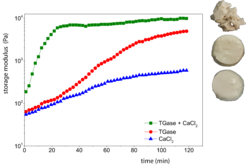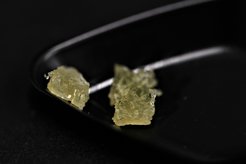Oil bodies from plant seeds
Oil bodies, also referred to as oleosomes, are spherical structures with a lipid core (triacylglycerides) that is surrounded by a monolayer of phospholipids and an outer layer of integral proteins, mainly oleosins. By extracting them from plant seeds, a naturally pre-emulsified oil-in-water emulsion is obtained (Fig. 1). Understanding the link between macro- and microscopic properties of the oleosome emulsion and the respective structure at the molecular level is a prerequisite to develop a rational structure-based design for oleosome products.

Oleosome emulsions bear the potential to be used as templates for the preparation of solid and soft-solid materials. In this regard, the functionalized surface of oleosomes can be exploited to conveniently bind different type of molecules, e.g. divalent ions (Ca2+ ) , transglutaminase (Fig. 2). In a similar way, oleosome flow behavior can be tuned with different type of hydrocolloids (Fig. 3), which depending on many processing conditions can provide a new dimension to food structure design. However, efficient exploitation of oleosomes requires fundamental understanding of the molecular properties when associated with these molecules. It is therefore promising to elucidate the molecular interactions, with the hope that a better understanding will pave the way for the creation of a vast array of structures with potential in food texture design.




